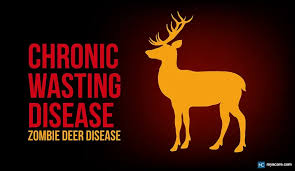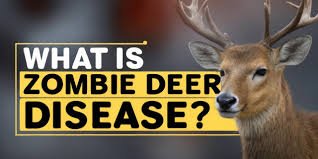Is Zombie Deer Disease Dangerous for Humans?
Introduction to Zombie Deer Disease
Zombie Deer Disease (CWD – Chronic Wasting Disease) is a fatal neurological condition that primarily affects deer, elk, and moose populations. The disease, which has been spreading across North America, has raised concerns due to its potential to impact wildlife and its unknown implications for humans. CWD is caused by prions, which are misfolded proteins that attack the brain, leading to a characteristic wasting, or “zombie-like” behavior in infected animals. The disease’s alarming spread in wildlife populations has triggered investigations into its potential risks to human health.
Transmission of CWD in Wildlife
CWD is primarily spread through contact with bodily fluids, such as saliva, urine, and feces, from infected animals. It can also be transmitted via contaminated environments, including soil and plants. The disease manifests as weight loss, behavioral changes, and coordination loss, ultimately leading to the animal’s death. The prions that cause CWD can persist in the environment for years, making containment efforts challenging.
Potential Risk to Humans
The critical question surrounding CWD is whether it can be transmitted to humans. As of now, there is no direct evidence that CWD affects humans. However, prion diseases are known to be transmissible across species in some cases, such as Bovine Spongiform Encephalopathy (mad cow disease) and its relation to Creutzfeldt-Jakob disease in humans. While the Centers for Disease Control and Prevention (CDC) and World Health Organization (WHO) state that there is no direct evidence linking CWD to human disease, they recommend caution, especially for hunters handling infected animals.
Cautionary Measures for Hunters and Public Health
Given the lack of definitive answers, public health organizations and wildlife experts urge caution. Hunters are advised not to consume meat from animals that exhibit signs of CWD or those found in regions with known outbreaks. Further research is necessary to fully understand the implications of the disease for humans, but for now, prevention remains key.

Why This News is Important:
Understanding the Potential for Cross-Species Disease Transmission
Zombie Deer Disease highlights an ongoing concern regarding prion diseases and their potential to jump species. As seen with previous cases like mad cow disease, prions can cause devastating diseases in humans when transmitted from animals. Although no human cases have been confirmed with CWD, the risk of cross-species transmission remains a critical area of research. This news emphasizes the importance of monitoring wildlife diseases, as they could have unforeseen consequences for public health.
Impact on Wildlife and Ecosystem
The spread of CWD in deer, moose, and elk populations is also a concern for ecosystems. As these animals are key species in many North American habitats, their decline could have a ripple effect on the balance of these ecosystems. The ongoing outbreak threatens the population of these animals, which could impact hunting, tourism, and local economies. It’s essential for authorities to closely monitor wildlife health and take steps to control the spread of CWD.
Precautionary Health Measures for Hunters and Consumers
For students preparing for government exams, especially in fields related to health and wildlife management, it’s important to note the significance of guidelines for hunters and the general public. The CDC and other health organizations have issued warnings about the potential risks associated with hunting in areas affected by CWD. These precautions are crucial in preventing any possible transmission to humans and maintaining public health safety.
Historical Context:
Prion Diseases and Previous Outbreaks
Prion diseases have a long and concerning history of affecting both animals and humans. The most notable example is Bovine Spongiform Encephalopathy (BSE), commonly known as mad cow disease. In the 1980s and 1990s, mad cow disease spread among cattle in the UK and Europe, leading to a significant public health crisis when it was found to be linked to Creutzfeldt-Jakob Disease (CJD) in humans. Although CWD has not been shown to affect humans directly, the historical context of prion diseases has heightened awareness of their potential dangers. This history has led to increased monitoring of CWD and its possible transmission routes.
CWD Discovery and Spread
CWD was first identified in the 1960s in captive mule deer at a Colorado research facility. Since then, it has spread to wild populations in North America, including the U.S. and Canada, with confirmed cases in several states and provinces. Although CWD is not new, its rapid spread over the years has spurred wildlife agencies to investigate potential solutions and preventative measures. As the disease continues to expand its geographical reach, scientists and wildlife experts remain focused on understanding its environmental persistence and how it might affect other species.
Key Takeaways from “Is Zombie Deer Disease Dangerous for Humans?”
| # | Key Takeaway |
|---|---|
| 1 | Zombie Deer Disease (CWD) is a fatal neurological disease affecting deer, moose, and elk. |
| 2 | CWD is caused by prions, misfolded proteins that attack the brain and lead to behavioral changes in infected animals. |
| 3 | No evidence linking CWD to humans yet, but prion diseases can potentially be transmitted across species. |
| 4 | Transmission of CWD occurs through bodily fluids or contaminated environments, making it difficult to contain. |
| 5 | Public health organizations advise caution for hunters and consumers, especially in areas affected by CWD outbreaks. |
Important FAQs for Students from this News
1. What is Zombie Deer Disease (CWD)?
Zombie Deer Disease, also known as Chronic Wasting Disease (CWD), is a fatal neurological disease affecting deer, elk, moose, and other cervids. It is caused by prions, misfolded proteins that lead to degeneration in the brain, resulting in behavioral changes and eventual death of the affected animals.
2. How is Zombie Deer Disease transmitted?
CWD is primarily transmitted through direct contact with bodily fluids (saliva, urine, feces) of infected animals. It can also spread through contaminated environments like soil and plants, where prions can persist for years.
3. Can Zombie Deer Disease affect humans?
As of now, there is no conclusive evidence linking CWD to human disease. However, prion diseases in other animals, such as mad cow disease, have been linked to human health risks, so caution is advised.
4. What are the symptoms of Zombie Deer Disease in animals?
Infected animals exhibit symptoms such as weight loss, behavioral changes (including a lack of fear of humans), drooling, difficulty walking, and coordination loss. Ultimately, the disease leads to death.
5. What precautions should hunters take when hunting in areas with CWD
Hunters are advised not to consume meat from animals showing signs of CWD or those found in areas where the disease is known to be present. It is also recommended to avoid handling the brain or spinal tissue of infected animals.
6. How widespread is Zombie Deer Disease?
CWD has been confirmed in several North American states and provinces, affecting wild and captive deer populations. It continues to spread, posing challenges for wildlife management.
Some Important Current Affairs Links

















